Fire Extinguisher Guide
In the UK, fire extinguishers are colour-coded to help people quickly identify and use them in a worst-case fire scenario.
Understanding the various types of fire extinguishers and their corresponding colours is crucial for ensuring safety in homes, workplaces, and public spaces.
Our helpful guide provides a comprehensive overview of the five fire extinguisher colours: Red, Cream, Blue, Black, and Yellow, and the classes of fires they’re used for, and their specific applications.
A breakdown of the different types of fire extinguisher
Use the following chart to cross reference which type of fire extinguisher can be used for the different fire classes.
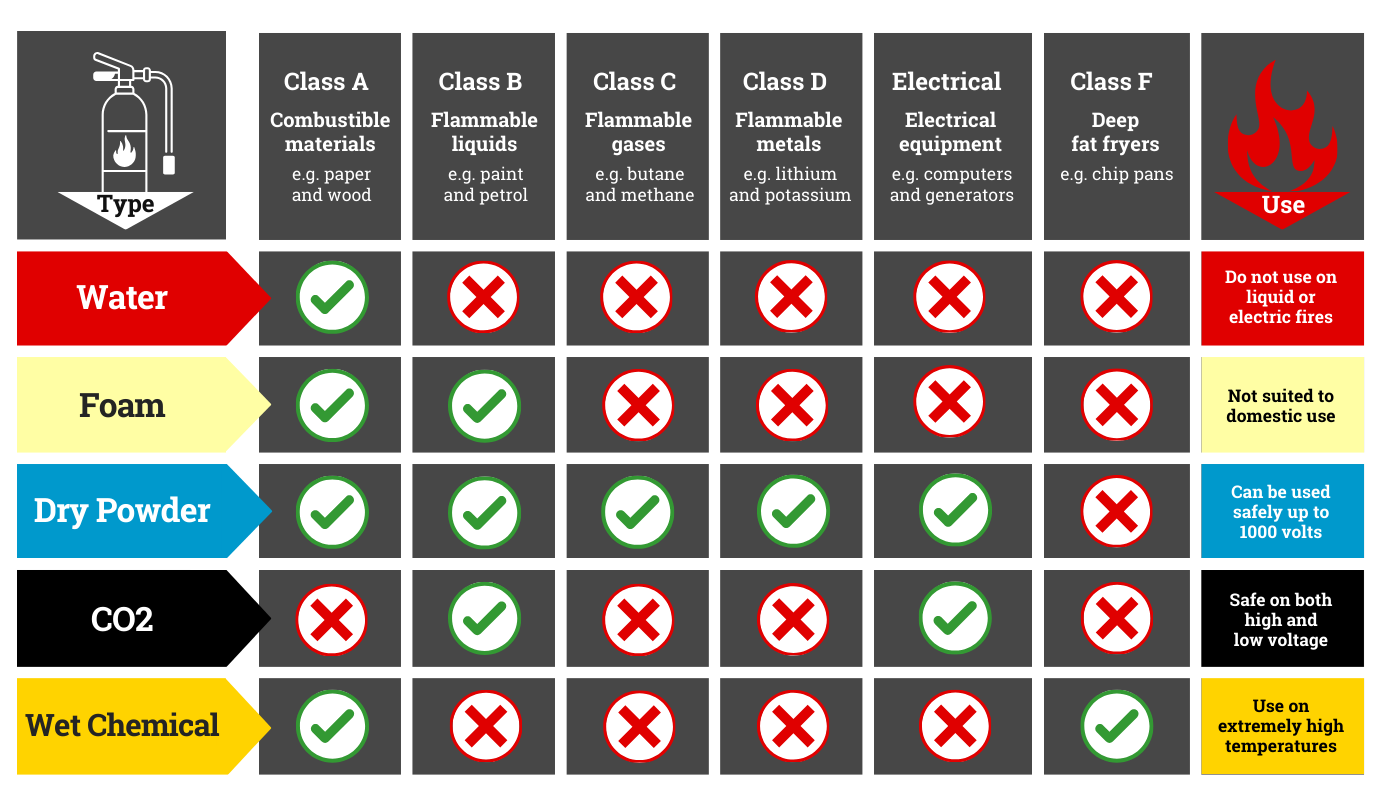
Knowing the fire extinguisher types
Five types of fire extinguishers help extinguish the various fire types.
- Water (Red)
- Foam (Cream)
- Dry Powder (Lilac)
- Carbon Dioxide CO2 (Black)
- Wet Chemical (Yellow)
Water Extinguishers (Red)
Overview: The water extinguisher, identifiable by its red label, is the most traditional and widely recognised.
It’s specifically designed to tackle Class A fires involving common combustible materials such as wood, paper, and textiles.
The simplicity of its operation and the general availability of water make it a popular choice in various settings.
However, it’s crucial to remember that water conducts electricity and can spread burning oil or fat, making these extinguishers unsuitable for electrical, cooking oil, and flammable liquid fires.
The primary aim is to protect life by ensuring that all building occupants have sufficient warning to evacuate safely in the event of a fire.
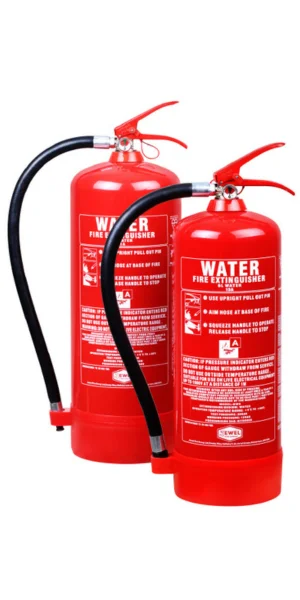
Key facts:
Typical use
Effective on paper, wood and fabric
Exclusions
Never use on electrical fires, oil, or fat fires
Locations
Ideal for schools, offices, and domestic premises
Typical use cases for water fire extinguishers

Water fire extinguishers are particularly effective for settings with a high presence of organic, combustible materials.
They should be avoided in situations involving electrical equipment, flammable liquids, or cooking oils.
Typical use cases for water
fire extinguishers
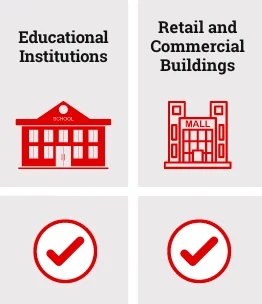
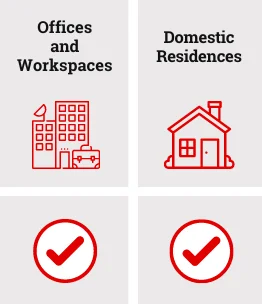
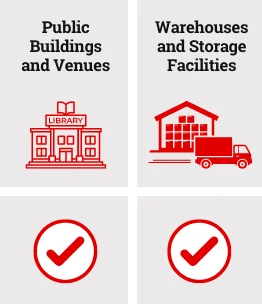
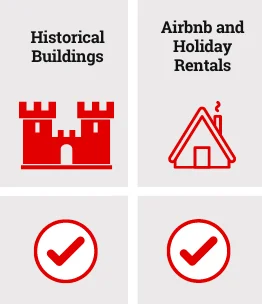
Water fire extinguishers are particularly effective for settings with a high presence of organic, combustible materials.
They should be avoided in situations involving electrical equipment, flammable liquids, or cooking oils.
Educational Institutions
Schools, colleges, and universities often have combustible materials like paper, wood, and textiles. Water extinguishers are suitable for classrooms, libraries, and administrative areas where these materials are prevalent.
Retail and Commercial Buildings
Retail environments, such as shops and malls, often contain a lot of Class A combustibles.
Water extinguishers can be used for fires involving merchandise, display materials, and decorations.
Offices and Workspaces
In office environments, water extinguishers are effective against fires involving paper, wood, and fabric, which are common materials in these settings. They can be used for fires originating from waste bins, desks, chairs, and shelving.
Domestic Residences
Water extinguishers are effective for common household fires involving furniture, textiles, and paper products in homes.
They are suitable for living areas, bedrooms, and home offices.
Public Buildings and Venues
Places like theatres, museums, and galleries, which often contain many organic materials, can benefit from water extinguishers for tackling fires in seating areas, stages, and display rooms.
Warehouses and Storage Facilities
Retail environments, such as shops and malls, often contain a lot of Class A combustibles. Water extinguishers can be used for fires involving merchandise, display materials, and decorations.
Historical Buildings
Water extinguishers are a primary choice for controlling fires without the risk of chemical damage that other types of extinguishers might cause in buildings with a lot of wooden structures and furnishings.
Airbnb and Holiday Rentals
Talk to us about high quality water fire extinguishers for your business
Foam Extinguishers (Cream)
Overview: Foam fire extinguishers, marked with a cream label, are versatile and effective on both Class A (solid combustibles) and Class B (flammable liquids) fires. They are particularly valuable in areas where there is a risk of fires involving both types of materials.
By creating a blanket of foam, they effectively smother the flames, cutting off the fire’s oxygen supply and preventing re-ignition. This action not only extinguishes the fire but also significantly reduces the risk of it spreading. Foam extinguishers are particularly valued in environments where flammable liquids are stored or handled, such as in garages, workshops, and industrial sites. Their capability to tackle a wide range of fires without causing extensive damage to property or equipment makes them a preferred choice for both commercial and residential fire safety.
Primary aim: Suitable for Class A and B fires.
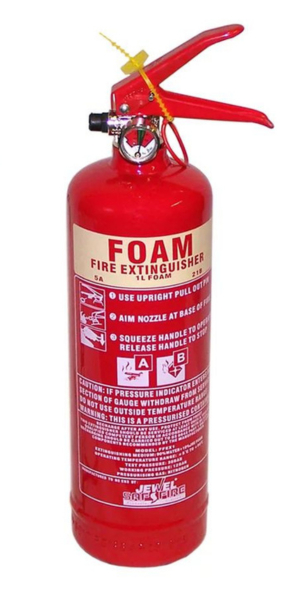
Key facts:
Typical use
Effective on fires involving solids and flammable liquids
Exclusions
Not suitable for kitchen fires or those involving electrical equipment
Locations
Commonly found in business premises, warehouses, and garages
Typical use cases for foam fire extinguishers

Foam extinguishers are versatile and particularly effective on Class A and B fires. These extinguishers form a cooling blanket over the fire, cutting off the oxygen supply and suppressing flames.
They are ideal for situations involving flammable liquids like petrol or paint but are also effective on solid combustibles.
Typical use cases for foam
fire extinguishers
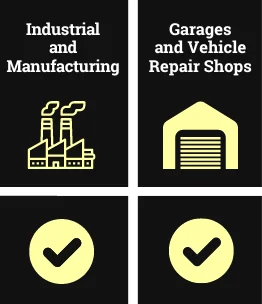
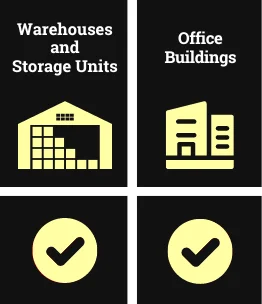
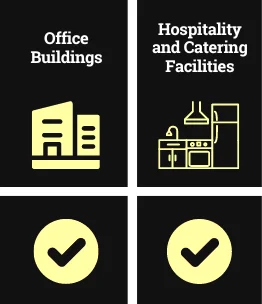
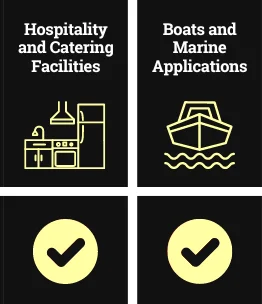
Foam extinguishers are versatile and particularly effective on Class A and B fires. These extinguishers form a cooling blanket over the fire, cutting off the oxygen supply and suppressing flames.
They are ideal for situations involving flammable liquids like petrol or paint but are also effective on solid combustibles.
Industrial and Manufacturing
These settings often deal with flammable liquids such as paints, solvents, and fuels. Foam extinguishers are ideal for rapidly suppressing fires involving these substances without the risk of re-ignition.
Garages and Vehicle Repair Shops
There is a risk of petrol and diesel fires in areas where vehicles are present. Foam extinguishers are well-suited for such environments as they can effectively combat liquid fuel fires.
Warehouses and Storage Units
Foam extinguishers are helpful in warehouses storing both flammable liquids and solid materials like wood, paper, and textiles, providing a versatile fire-fighting solution.
Office Buildings
While less common in standard office environments than water extinguishers, foam extinguishers can be helpful in office areas with a higher risk of flammable liquid fires, such as in maintenance areas or where cleaning chemicals are stored.
Hospitality and Catering Facilities
Foam extinguishers can be used in kitchens and catering areas for fires involving flammable liquids, but they are not suitable for fires involving cooking oils (Class F). However, they can be a secondary choice for general areas in these establishments.
Boats and Marine Applications
Foam extinguishers can be effective for boat fires, especially in engine areas where fuel fires are risky. They can suppress the fire quickly and prevent re-ignition. The extinguisher has an additional MED-type approval.
Aviation Facilities
Foam extinguishers can be used at airports and in hangars to extinguish flammable liquids commonly found in these settings. Aviation fuels like heptane require specialist foam fire extinguishers.
Fuel Storage Areas
Foam extinguishers, which are effective on liquid fires, can benefit locations where large quantities of fuel are stored, such as fuel depots or reserve tanks.
Talk to us about high quality foam fire extinguishers for your business
Dry Powder Extinguishers (Blue)
Overview: Dry Powder fire extinguishers, marked with a lilac label (formerly blue), are highly versatile and can be used on Class A, B, C, D* and electrical fires, making them suitable for a variety of environments.
Their firefighting prowess stems from a powder formula that interrupts the chemical reaction of fire, effectively smothering flames across a variety of materials. This broad applicability makes them ideal for industrial settings, garages, and vehicles where these fire types are prevalent. However, their use can result in visibility issues and potential damage to electrical equipment due to residue. Despite this, their ability to address multiple fire classes simultaneously makes them invaluable in emergency situations where the specific nature of a fire might be unknown.
Primary aim: can be used to extinguish Class A, B, C, D and electrical fires. blue-labeled powder extinguishers offer a versatile solution for various fire emergencies.
* The colour‐code for class D Powder extinguishers (for metal fires) has changed from Blue to Signal Violet. For more information, see BAFE.org.uk.
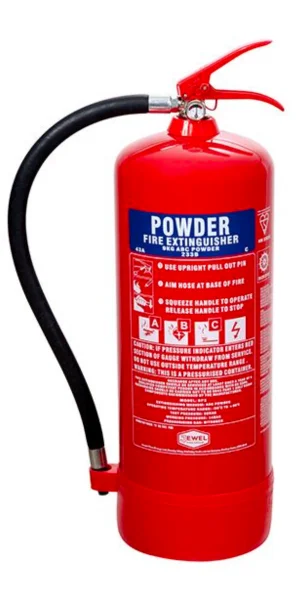
Key facts:
Typical use
Highly versatile and can be used on Class A, B, C and electrical fires
Exclusions
Not recommended for use in enclosed spaces
Locations
Industrial usage such as factories, workshops and garages
Typical use cases for dry powder fire extinguishers

Dry powder fire extinguishers are an excellent choice for areas with multiple types of fire risks, especially where flammable liquids, gases, or electrical risks are present.
However, their use requires caution, particularly in enclosed spaces and where there’s a risk of re-ignition.
Typical use cases for dry powder
fire extinguishers
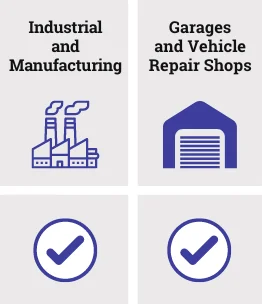
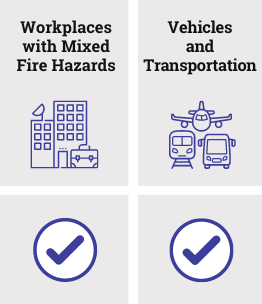
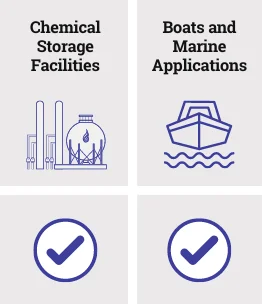
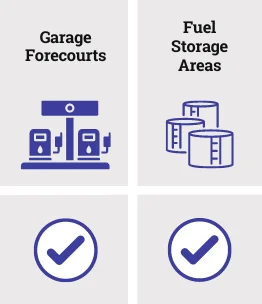
Dry powder fire extinguishers are an excellent choice for areas with multiple types of fire risks, especially where flammable liquids, gases, or electrical risks are present.
However, their use requires caution, particularly in enclosed spaces and where there’s a risk of re-ignition.
Industrial and Manufacturing
Dry powder extinguishers are invaluable in settings where there’s a risk of fires involving gases, liquids, and solids, such as manufacturing plants and industrial sites. They can tackle many fire types commonly found in these environments.
Garages and Vehicle Repair Shops
These areas often deal with flammable liquids like petrol and oils and electrical risks. Powder extinguishers are effective for quickly suppressing fires involving vehicle fuels, oils, and electrical components.
Workplaces with Mixed Fire Hazards
In workplaces where the fire risk is varied, including combustible materials (wood, paper, textiles), flammable liquids, and gases, powder extinguishers offer a versatile solution.
Vehicles and Transportation
For marine environments, especially in engine and fuel storage areas, dry powder extinguishers are suitable for tackling fires involving flammable liquids and gases.
Chemical Storage Facilities
In areas where chemicals, which might be flammable or reactive, are stored or handled, dry powder extinguishers can provide effective fire suppression.
Boats and Marine Applications
For marine environments, especially in engine and fuel storage areas, dry powder extinguishers are suitable for tackling fires involving flammable liquids and gases.
Garage Forecourts
Fuel Storage Areas
Powder extinguishers are beneficial in locations where flammable liquids or gases are stored, such as fuel depots, gas storage facilities, and marinas, because they are effective for fires involving these substances.
Talk to us about high quality dry powder fire extinguishers for your business
Carbon Dioxide (CO2) Extinguishers (Black)
Carbon Dioxide (CO2)
Extinguishers (Black)
Overview: Carbon Dioxide (CO2) fire extinguishers, recognised by their black label, are specifically designed for electrical fires and are also effective on Class B (flammable liquid) fires. Their unique properties make them ideal for certain environments and situations.
CO2 extinguishers work by displacing oxygen around the fire and removing the heat with a cold discharge, effectively suffocating the fire without leaving any residue. This makes them ideal for use on electrical fires in offices, data centres, and server rooms, as they cause no damage to the electrical components and machinery.
Their non-conductive nature ensures safety during use on electrical fires, but they are not suitable for Class A (solid combustibles) or Class F (cooking oils/fats) fires. CO2 extinguishers are essential for protecting technological and electrical infrastructure from fire damage.
Primary aim: to extinguish Class B and electrical fires.
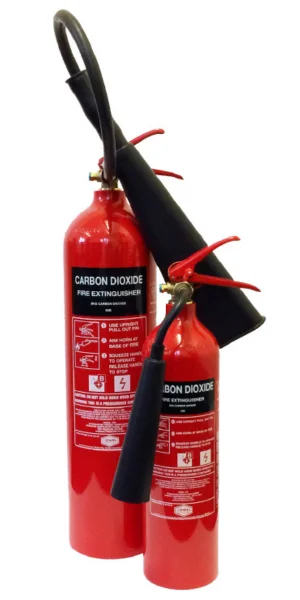
Key facts:
Typical use
Effective on fires involving electrical equipment and flammable liquids
Exclusions
Ineffective on Class A, C, and D fires.
Locations
Essential in offices, server rooms, and areas with electrical equipment
Typical use cases for carbon dioxide (CO2) fire extinguishers

CO2 fire extinguishers are ideal for environments with a lot of electrical equipment or where flammable liquids are present.
Their ability to extinguish fires without leaving residue makes them a critical tool in protecting
sensitive equipment and environments from fire damage.
Typical use cases for carbon dioxide (CO2) fire extinguishers
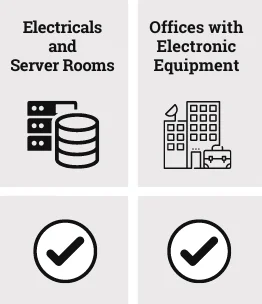
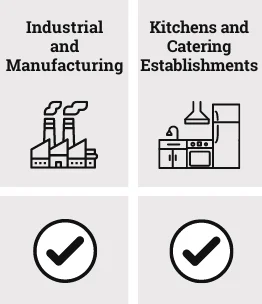
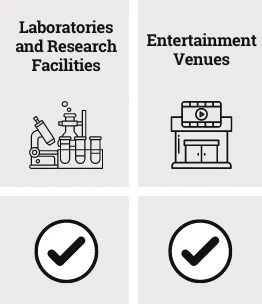
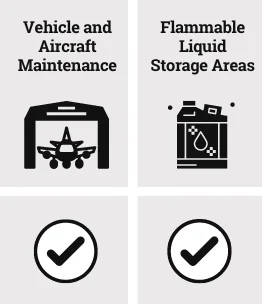
CO2 fire extinguishers are ideal for environments with a lot of electrical equipment or where flammable liquids are present.
Their ability to extinguish fires without leaving residue makes them a critical tool in protecting
sensitive equipment and environments from fire damage.
Electricals and Server Rooms
CO2 extinguishers are perfect for fires in electrical equipment as they don’t leave any residue, which could harm sensitive electronics. They are widely used in server rooms, data centres, and areas with significant electrical installations.
Offices with Electrical Equipment
In modern offices equipped with computers, printers, and other electronic devices, CO2 extinguishers are essential for safely extinguishing any electrical fire without damaging the equipment.
Industrial and Manufacturing
For industries that use electrical machinery or have areas with a high concentration of electrical equipment, CO2 extinguishers provide an effective fire-fighting solution without the risk of damaging the machinery.
Kitchens and Catering Establishments
While unsuitable for cooking oil fires, CO2 extinguishers can be used in kitchens for electrical fires, such as those involving electrical cooking appliances.
Laboratories and Research Facilities
In environments with many electronic instruments, such as research labs or pharmaceutical facilities, CO2 extinguishers are ideal for tackling any fire involving these devices.
Entertainment Venues
Vehicle and Aircraft Maintenance
In locations where flammable liquids are stored or handled, CO2 extinguishers can effectively handle any fire outbreak involving these substances without leaving a residue.
Flammable Liquid Storage Areas
CO2 extinguishers are beneficial in theatres and concert halls, where electrical equipment and flammable materials mix. They can quickly extinguish fires without damaging equipment or leaving residue.
Talk to us about high quality carbon dioxide C02 fire extinguishers for your business
Wet Chemical Extinguishers (Yellow)
Overview: Wet chemical fire extinguishers, identified by their yellow label, are specially designed for Class F fires, particularly those involving cooking oils and fats and are typically found in commercial kitchens.
When discharged, they utilise a solution that reacts with the burning oil to form a soap-like substance, effectively cooling and smothering the fire to prevent re-ignition. The saponification process is unique to wet chemical extinguishers, making them indispensable in environments with deep-fat fryers and other cooking appliances. Their effectiveness and safety in quickly extinguishing potentially devastating kitchen fires make them a crucial tool in commercial cooking settings.
Primary aim: To quickly extinguish Class F fires involving cooking oils and fats.
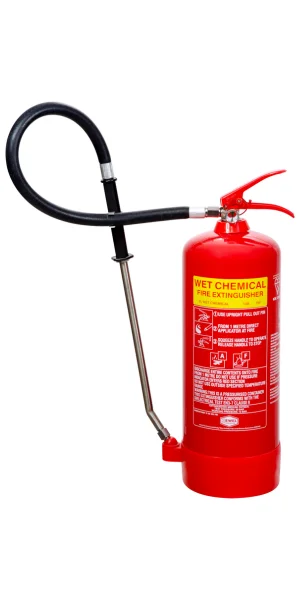
Key facts:
Typical Use
Effective on cooking oil and fat fires
Exclusions
Limited use on other
fire types
Locations
A must-have in commercial kitchens and food processing areas
Typical use cases for wet chemical fire extinguishers

Typical use cases for wet chemical fire extinguishers

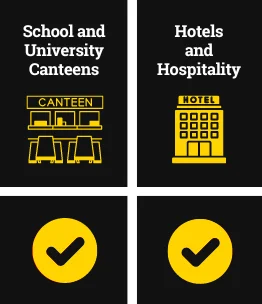
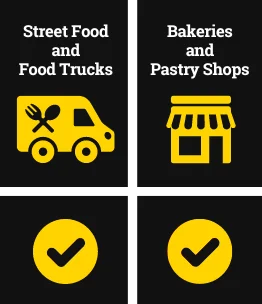
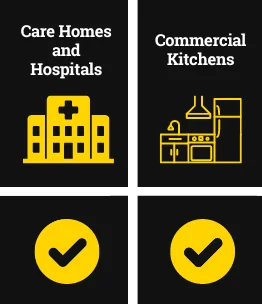
Wet chemical fire extinguishers, identified by their yellow label, are specially designed for Class F fires, particularly those involving cooking oils and fats.
They are a critical tool in specific environments where these types of fires are a high risk.
Catering Businesses
Catering companies should have wet chemical extinguishers on hand, especially those with mobile cooking units or temporary kitchen setups. These environments often involve cooking with oils and fats, which pose a significant fire risk.
Food Processing Plants
In facilities where large quantities of oils and fats are used or produced, such as in food processing plants, these extinguishers are vital for quickly suppressing fires specific to these materials.
Schools and University Canteens
Wet chemical extinguishers are essential in schools and university canteens because they effectively combat fires caused by cooking oils and fats. They ensure rapid suppression, minimise damage and enhance safety for students and staff by preventing fire re-ignition.
Hotels and Hospitality
Kitchens in hotels and hospitality venues, which serve large numbers of people and often use extensive cooking equipment, should be equipped with wet chemical extinguishers for immediate response to cooking oil fires.
Street Food and Food Trucks
For mobile food vendors and food trucks, where space is limited and cooking is done in close quarters, a wet chemical extinguisher is crucial for safety.
Bakeries and Pastry Shops
These establishments often deal with cooking oils and fats, making wet chemical extinguishers a necessary safety tool.
Care Homes and Hospitals
Kitchens in care homes and hospitals, which operate similarly to commercial kitchens, also benefit from the presence of wet chemical extinguishers.
Commercial Kitchens
Wet chemical extinguishers are essential in restaurants, cafeterias, and other commercial cooking environments. They are the most effective means for extinguishing fires caused by overheating cooking oils in deep-fat fryers and pans.
Talk to us about high quality wet chemical fire extinguishers for your business
Other Fire Safety services
FIRE RISK ASSESSMENTS
FIRE ALARMS
FIRE SAFETY TRAINING
FIRE EXTINGUISHERS
Total client protection since 2004
At IPS, your security is our priority. You need dependable protection 24/7, 365 days a year, and for that reason, our engineers are always available. You can depend on us to ensure you are always protected.
100% INDEPENDENT
We’re fully independent, providing unbiased solutions tailored just for you.
EXPERTISE
CUSTOMER-FIRST
COMPREHENSIVE COVERAGE
We're trusted by some fantastic organisations

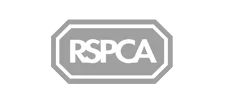


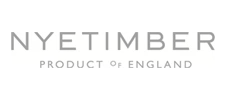



Contact us for a free quote
Or call the team on 0333 444 5 999
Our Priority is You
We pride ourselves on the impeccable service we provide our customers. From the first conversation to ongoing support for your fire, security and safety needs, you'll wonder why you left it so long to contact us.

